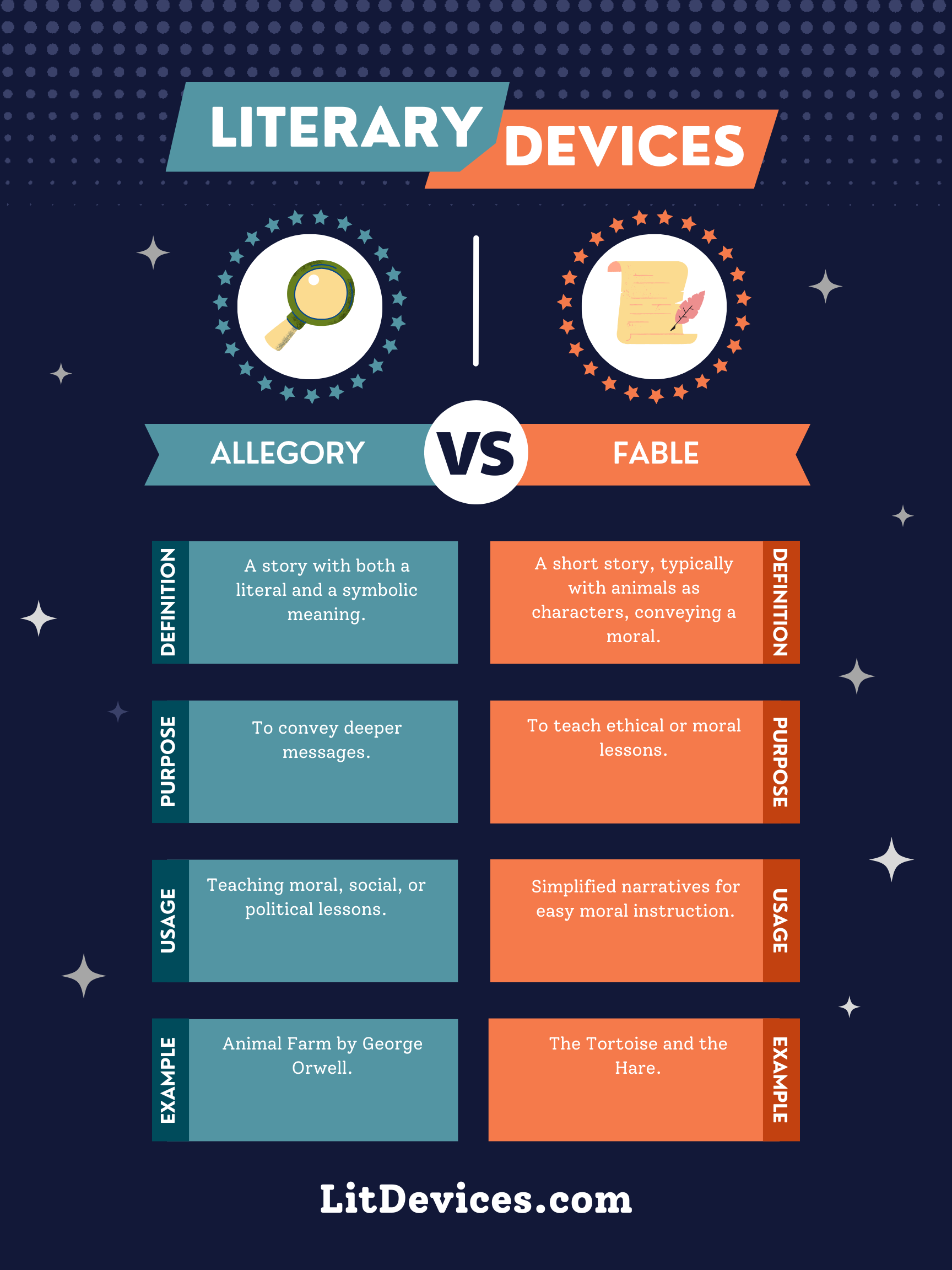Allegory is a complex narrative that conveys hidden meanings through symbolic figures; Fable is a short story conveying a moral, often with animals as characters.
Allegory 🌌
Allegory presents a narrative with a dual meaning—both a surface story and a deeper, symbolic message. It’s often used to explore complex ideas like morality, politics, or philosophy. A classic example is George Orwell’s “Animal Farm,” where a farm operated by animals symbolizes the events leading up to the Russian Revolution of 1917 and the early Soviet Union, with each animal representing different social classes or political figures.
Fable 🐾
Fable, on the other hand, is a concise narrative that imparts a moral lesson, typically through animal characters with human traits. These stories are straightforward and designed to teach ethical principles, especially to children. Aesop’s Fables, such as “The Tortoise and the Hare,” where the slow and steady tortoise wins a race against the fast but overconfident hare, is a prime example. The moral? “Slow and steady wins the race.”
Summary
| Literary Device | Definition | Purpose | Usage | Relevant Examples |
|---|---|---|---|---|
| Allegory | A narrative with both a surface story and deeper symbolic meanings. | To explore complex ideas and convey hidden messages. | Often found in novels, films, and longer works. | “Animal Farm” by George Orwell. |
| Fable | A short story that imparts a moral, often featuring animals with human traits. | To teach moral or ethical lessons in a simple manner. | Common in children’s stories and teaching materials. | “The Tortoise and the Hare” by Aesop. |
Writing Tips
When delving into allegory or fable in your writing, keep these tips in mind:
- For Allegory: Focus on the deeper message you want to convey. Develop your characters and settings with layers of meaning that readers can uncover over time. For example, in a dystopian allegory, each element of the world might represent aspects of our society for readers to interpret.
- For Fable: Keep it simple and direct. Fables are powerful because of their clarity and the straightforward moral at the end. When creating animal characters, imbue them with human-like traits that serve the lesson you’re aiming to teach, such as the cunning of a fox or the diligence of an ant.
FAQs
Q: Can a story be both an allegory and a fable?
A: While rare, it’s possible for a story to blend elements of both, using animals to convey morals while also embedding deeper symbolic meanings.
Q: Are allegories always serious and fables always for children?
A: Not necessarily. While allegories often tackle serious themes, they can be written in a light-hearted manner. Similarly, fables, despite being popular with children, can offer profound insights for adults.
Q: How long are allegories compared to fables?
A: Allegories tend to be longer, as they need space to develop their complex meanings, while fables are typically short and succinct.
Exercise
Read the following paragraph and decide if it’s more aligned with an allegory or a fable:
“A wise old owl sat on an oak, watching as a boastful hare challenged a quiet tortoise to a race. Unfazed by mockery, the tortoise accepted, and to everyone’s surprise, won, teaching the hare the value of persistence and humility.”
Answers:
- This paragraph describes a Fable because it features animal characters with human traits conveying a clear moral lesson.
Other Device Comparisons You May Find Interesting
- Metaphor vs Simile: Delving into direct and indirect comparisons.
- Symbolism vs Allegory: Unpacking layers of meaning versus direct representation.
- Parable vs Myth: Exploring lessons from life versus traditional stories explaining natural or social phenomena.
- Satire vs Parody: Examining criticism through exaggeration versus humorous imitation.
Embarking on a journey through Allegory and Fable unveils the richness of literary devices, enhancing our appreciation for the art of storytelling and its capacity to reflect and teach profound truths.

